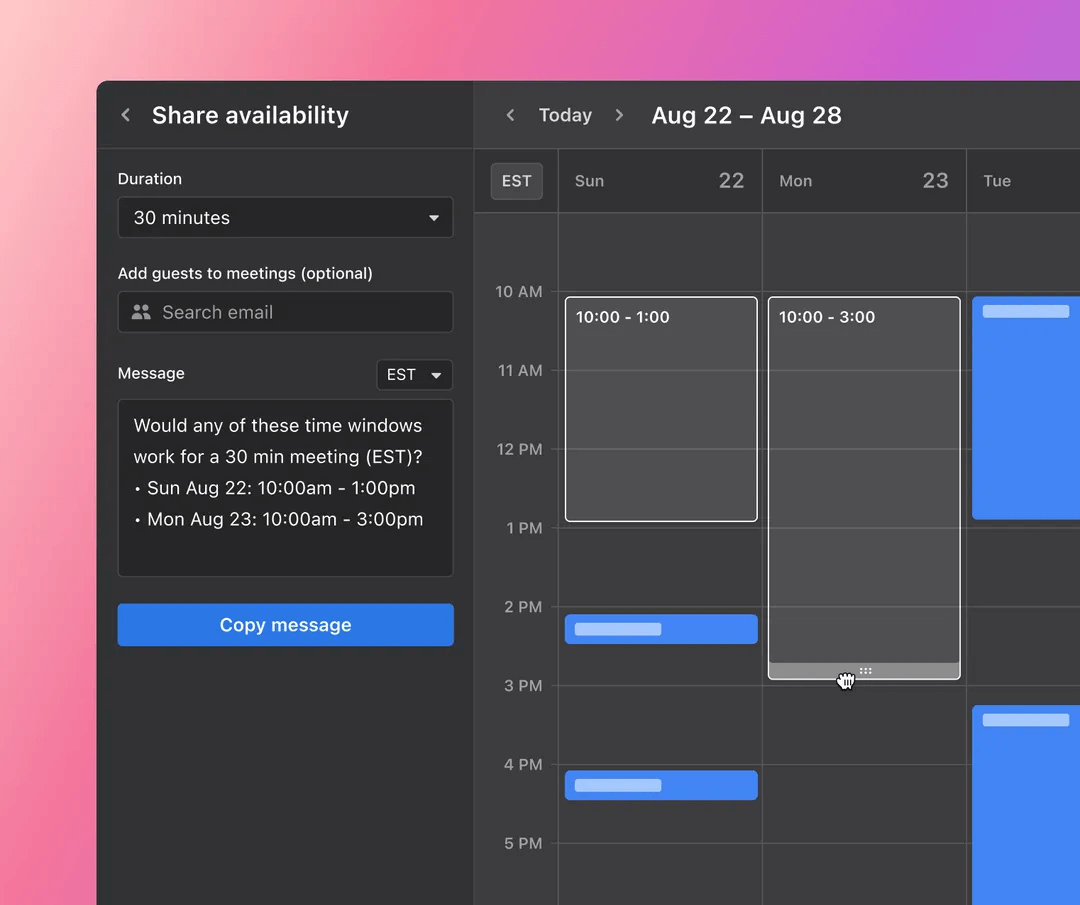The first step to building a thriving and motivated team is to gauge their engagement. Is your team genuinely invested or just going through the motions? By understanding what drives and resonates with them, you’ll build a workplace where passion meets purpose.
This guide shows you how to measure employee engagement. It also looks at common challenges, measurement metrics, and strategies for evaluating team engagement.
Why should you measure employee engagement?
Employee engagement reflects the connection employees have with their workplace. It embodies the emotional and mental investment people make as they carry out their work duties.
Measuring employee engagement is important because it directly impacts an organization’s success. Engaged employees are central to a company’s competitiveness, as they’re more productive, proactive, and more likely to stay with their current employer. In fact, 92% of executives claim their engaged employees perform better than their disengaged employees.
Assessing your employees’ level of engagement can also help your business identify specific areas that need attention and improvement, ultimately enhancing workplace morale, increasing retention rates, boosting productivity, and ensuring operational excellence.
Employee engagement measurement: common challenges
Measuring employee engagement can be tough because it’s more than just analyzing numbers and clear-cut data. You also have to consider people’s feelings, motivations, and the unseen factors that affect their day-to-day work lives.
Here are just a few of the challenges managers often come across when measuring employee engagement:
Subjectivity in self-reporting
Understanding how employees really feel can be especially tricky when they’re asked to rate their own engagement.
Your employees may sometimes tell you what they think you want to hear if they are worried about potential negative consequences.
Other times, their emotional state can affect their feedback. Maybe they had a bad day or week, for instance. As a result, their answers might reflect those short-term feelings, creating a response based on a temporary circumstance rather than their typical sentiments.
These factors make it hard to get a true read of what’s going on in the workplace.
One-size-fits-all approach
The one-size-fits-all approach to measuring employee engagement often falls short because it doesn’t account for individual differences. What motivates one team member might not inspire another.
Generic surveys might overlook what specifically drives each person, special team dynamics, or cultural differences.
 |
When the same questions are used to measure all employee experiences, the nuances of individual preferences and perspectives can be easily lost. This lack of personalization can cause misunderstandings and missed opportunities to build a more connected and motivated workplace.
Identifying genuine engagement
Identifying genuine engagement goes beyond surface-level observations. It’s not uncommon to find employees who appear to be productive, work long hours, or finish tasks quickly but are actually focusing on low-priority tasks or lack emotional investment in their work.
True engagement means the employee sees value in their work and is committed to helping the company achieve its goals. Over-reliance on visible metrics, like hours worked or tasks completed, can lead to misconceptions about an employee’s engagement level.
Frequency and timing
The frequency and timing of employee engagement surveys can significantly sway these surveys’ results. If the assessments are done during exceptionally stressful periods or unusually slow times, the feedback might not accurately reflect the typical employee experience.
Moreover, using infrequent surveys, like those done annually or bi-annually, means companies might miss out on resolving workplace challenges or making improvements. Management may be out of touch with current employee sentiments and potential issues simmering below the surface.
5 employee engagement metrics
The following five key employee engagement metrics can provide you with a deeper understanding of your workforce’s commitment, satisfaction, and alignment with your company’s goals:
1. Job satisfaction metrics
Understanding whether your employees find fulfillment in their roles will help you discern their engagement. If an employee finds their tasks meaningful and aligned with their career goals, they’re more likely to invest genuine effort and initiative — both of which are direct indicators of authentic engagement.
Here are some metrics that can help indicate your employees’ job satisfaction:
- Employee Net Promoter Score (eNPS): Measures the likelihood of your employees recommending your company as a good place to work.
- Employee Satisfaction Index (ESI): A comprehensive measure that assesses various aspects of an employee’s experience and satisfaction.
- Turnover rates: High employee turnover rates could indicate underlying dissatisfaction among employees. Take a closer look at your employees’ work conditions, and conduct exit interviews with those who leave.
- Task completion rates: Consistent and efficient task completion suggests contentment with responsibilities, while delays or incomplete projects might point to dissatisfaction or workload issues.
- Skills and responsibilities alignment: Do your employees feel they are genuinely applying their skills and expertise to their roles? A mismatch between an employee’s talents and their job duties can indicate the need for role reevaluation or upskilling opportunities.
2. Team and relationship dynamics
Strong, positive relationships within a team naturally foster an environment of collaboration and heightened productivity.
Conversely, a disconnected team can impede performance and dampen spirits.
Take a look at the following factors when determining the team and relationship dynamics among your employees:
- Collaboration quality: Evaluate the outcomes of team projects to assess the effectiveness of collaborations.
- Communication levels: Analyze the frequency and quality of internal communications such as email exchanges, meetings, or instant messages.
- 360-degree feedback: Feedback from all team members about their peers will provide you with quantifiable data on interpersonal relationships and team functionality.
3. Professional growth and development
Professional growth and development also indicate employee engagement levels since they signify an employee’s willingness to integrate deeply into their role, their team, and the company mission.
- Promotion rates: Reviews of promotion rates help gauge whether employees gain clear advancement opportunities, influencing their long-term commitment.
- Training participation: Employees’ involvement in skill-enhancement programs and dedication to self-learning indicate their commitment to personal growth and job role effectiveness.
- Performance reviews: Regular assessments can track individual milestones, such as role transitions, project leadership, or the acquisition of new responsibilities. This provides a comprehensive picture of employees’ professional development journeys.
4. Work-life balance indicators
A healthy work-life balance helps prevent burnout and promotes employee loyalty. This often translates into a more engaged, productive, and positive workforce.
 |
Here are several ways to determine work-life balance in your employees:
- Flexible work options utilization: Tracking the company’s use of remote work or flexible hours can indicate employees’ need for balance and current satisfaction levels.
- Break patterns: Observing the nature and frequency of breaks taken by employees can offer insights into stress levels and overall well-being.
- Absenteeism rates: High absenteeism may signal burnout or unhappiness. These issues might reflect an imbalance that requires attention.
- Employee feedback: Surveys or discussions about work-life balance can shed light on how employees perceive their current situation and well-being.
5. Organizational alignment
Organizational alignment is a clear indicator of employee engagement, as it reflects employees’ understanding of and commitment to the company’s mission and goals. Aligned employees are likely to be more engaged and contribute to initiatives that drive the company forward.
Here’s how you can determine your business’s organizational alignment:
- Project proposals: Employees suggesting initiatives or projects that resonate with the company’s mission signifies their buy-in and understanding of the company’s objectives.
- Active participation in feedback loops: Employees who offer feedback, contribute ideas, or voice concerns show they’re invested in the company’s success.
- Goal alignment: Understanding and sharing the company’s objectives in their work or team goals demonstrates employees’ alignment and commitment to the organizational journey.
How to measure employee engagement
Here are some tools you can use to more effectively and accurately measure employee engagement:
Surveys
Surveys offer a direct view into employee perspectives, offering structured data that can reveal trends in employee engagement levels.
Annual engagement surveys
An annual employee engagement survey is a comprehensive yearly survey conducted to assess employees’ overall feelings about their roles, the company, and company culture.
Pros:
- In-depth insights
- Tracks long-term sentiment
Cons:
- Time-consuming
- Outdated feedback
Pulse surveys
Pulse surveys are brief, frequent check-ins with employees. They’re ideal for quickly identifying and addressing emerging issues.
Setting reminders to conduct these surveys ensures consistency. Tools like Motion for scheduling can automate this process, making sure no check-in is missed.
Pros:
- Real-time feedback
- Promotes continuous improvement
Cons:
- May lack depth
- Possible survey fatigue among employees
eNPS surveys
As mentioned earlier, an eNPS focuses on how likely your employees are to recommend your company as a good workplace. It offers a snapshot of overall employee sentiment.
Pros:
- Easy to conduct
- Clear metric for satisfaction
Cons:
- Oversimplifies complex sentiments
- Lacks qualitative feedback
Non-survey methods
Non-survey methods provide alternative ways to understand employee engagement, allowing for more nuanced insights and mitigating the limitations and biases of traditional surveys.
One-on-one interviews
One-on-one interviews offer personal, direct interactions between managers and team members. They’re used for in-depth feedback that helps managers understand each individual employee's feelings.
Exit interviews are a type of one-on-one interview.
Pros:
- Rich feedback
- Build trust
Cons:
- Time-consuming
- Potential bias from own interpretation
 |
Focus groups
Focus groups involve a group of employees gathered together to discuss specific topics or issues. They provide collective insights and broader perspectives on workplace matters.
Use Motion to share availability and schedule meetings that work with everyone’s schedules — and ultimately simplify the focus group planning process.
Pros:
- Diverse perspectives
- Encourage open discussion
Cons:
- Conform to group consensus
- Extensive planning
Turnover and retention rates
As mentioned earlier, turnover and retention rates provide concrete data on employee engagement and reflect the company’s health. A high turnover rate may indicate underlying issues, whereas a high retention rate typically points to a committed and satisfied workforce.
Pros:
- Clear employee satisfaction indicators
- Predictive insights
Cons:
- Delayed insights
- Need further investigation to reveal reasons behind employee decision
Analytics
Analytics involves using different data forms, such as productivity metrics or employee engagement levels on internal platforms, to get a more objective view of employee engagement.
Pros:
- Data-driven
- Unbiased insights
- Identify unseen trends
Cons:
- Less personal insight
- Needs analysis expertise
- Potential privacy concerns
What to avoid when measuring employee engagement
Avoiding common pitfalls is just as critical as choosing the right employee engagement measurement methods. Steer clear of the common mistakes below for a more accurate assessment of your employee engagement levels.
Relying on one method of measurement
Using a single measurement approach can give you a skewed or incomplete view of employee engagement.
Multiple methods, however, capture varying aspects of the workforce’s sentiments. So, use a combination of methods for a more holistic view of engagement. A good bet is to mix surveys with open-ended questions and interviews.
Overlooking qualitative feedback
While quantitative data provides concrete metrics, qualitative feedback offers context and depth that can enrich your understanding of your employees’ engagement. Ignoring these insights can result in a limited view of the overall picture. It’s best practice to integrate both types of feedback for a comprehensive assessment.
For example, let’s say your annual survey indicates a significant drop in your team’s satisfaction score. Quantitative data alerts you to a problem; however, without qualitative feedback, you miss the context beneath the surface. Combining both types of feedback uncovers the root causes, which could include changes in team dynamics, communication issues, and increased workloads.
Focusing solely on high-performers
Although making sure your high-performers are engaged is important, don’t concentrate your efforts and attention solely on them. This may lead to missed opportunities for improvement and disregard for the broader workforce’s feelings and needs.
 |
Struggling employees may be the ones who need extra attention to boost their engagement so they can become valuable contributors to the team.
3 things to do after employee engagement measurement
So, what do you do with all the data and employee feedback you gain after measuring employee engagement?
It’s time to transform valuable insights into action to build a more motivated workforce.
1. Communicate results
Transparency builds trust. Openly sharing your results with the team demonstrates your honesty and commitment to improvement. Instead of brushing issues under the rug, you acknowledge them and show your employees you value their voices.
 |
Leveraging Motion as a direct communication channel enables employees to comment and share instant feedback, helping you address concerns promptly and make improvements collaboratively.
2. Make the necessary changes
Simply measuring engagement isn’t enough. Forty-one percent of employees have left a job because they felt unheard, and 37% have left because their feedback wasn’t taken seriously.
To truly enhance engagement, you need to transform feedback into tangible improvements. Motion can track these changes and monitor each team member’s progress. That way, no one is left behind, and teams are always aligned.
3. Follow up
Employee engagement is an ongoing journey. After implementing changes, it’s important to circle back with employees to see how the new strategies are impacting their work experience.
 |
Motion’s meeting assistant can help you easily schedule follow-ups with each employee. Regular meetings will help you keep the communication lines open and continue to fine-tune your employee engagement strategies.
Motion transforms engagement insights into actions
Motion empowers businesses to turn engagement insights into actionable strategies. The ability to communicate, schedule meetings, implement changes, and track results lets you drive meaningful change in your workplace. Build a more engaged and connected team with Motion.






